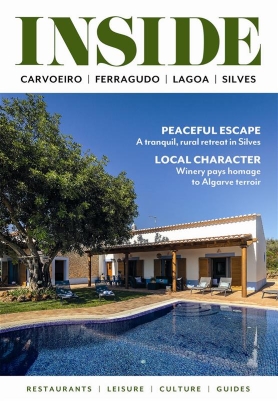ON THE TRAIL OF THE IBERIAN LYNX
The national breeding station of the Iberian lynx at the Herdade das Santinhas, close to Vale Fuzeiros near Silves, was set up in May 2009, as a compen- satory measure for damages to the environment during the construction of the Odelouca dam. Eighty five lynxes have been born there since then; 62 have survived. 44 cats were successfully released into the wild, most of them in Spain, but also in the Vale do Guadiana Nature Park, in the Eastern Algarve. There are currently 32 animals living in the breeding station, whose director Rodrigo Serra is very proud of the results. “Our project for the protection of one of the most endangered animals in the world is an enormous success, which is recognised on an international level and is considered to be exemplary.” The 41-year-old vet counts the arrival at the centre of the female Azahar, in 2009, amongst the most mem- orable moments. “It was the return of the Iberian lynx to Portugal, decades after this small cat had last been seen here,” says Serra. Further happy moments included the release of the first Iberian lynx in Portugal, near Mértola; the births of the first litters in the breeding station; and the first birth in the wild, in the Vale do Guadiana in May this year.
Khan made the headlines too. The male, born in the Silves centre and released into the wild in Castilla–La Mancha, in Spain, in November 2014, found its way back to Portugal and the Algarve and was finally recorded in Silves in September 2015. Unfortunately there was also something negative: in March 2015 – just one month after her release into the wild – Kayakweru was found dead near Mértola; she had been poisoned.
The location of the breeding station, in between two dams, is rather ironic, since their flooding added to the destruction of the habitat of the Iberian lynx. Further causes resulting in the Iberian lynx being one of the most endangered wild cats in the world today included the construction of motorways, which cut through their habitat, intensive farming, and the transformation of cork oak groves into eucalyptus plantations.
The loss of terrain also leads to the different lynx populations being unable to mix. This has led to interbreeding and thus genetic defects. In addition, this wild cat has also lost its main prey, the wild rabbit, the population of which has been strongly depleted by epidemics, among other factors. In recent years the Portuguese and Spanish governments have been collaborating to save the Iberian Lynx from extinction. The lynxes bred in the three Spanish centres and in Silves are primarily released in nature reserves in Spain. With a lack of wild rabbits, or extensive habitat areas, the Algarve still lacks the necessary conditions. Possible refuge areas have however already been identified in the Algarve and in the Alentejo.
The breeding station in Silves cannot be visited. The animals should have as little contact with humans as possible, so that they can be successfully released into the wild later on. However, in the context of the No Caminho do Lince Ibérico (On the Path of the Iberian Lynx) route, a project by nature conservation institute ICNF in collaboration with Monchique and Silves town councils and water supply company Águas do Algarve, an observation post has been built to the west of the breeding station, which is our destination today. The trip leads through the verdant, rolling hills of Silves, partly by car and partly on foot. We set off from Silves, the ancient capital of al-Gharb, as the Algarve was known during Moorish rule, towards São Bartolomeu de Messines on the EN 124, before turning left towards the dam (Barragem) and Vale Fuzeiros. After one kilometre, there is a fork leading to the hamlets of Gregórios and Canhestros to the right. We keep left, following the main road for a further two kilometres, before we drive up the hill to the Arade dam, on the left. A big stone column serves as a reminder that the Barragem do Arade was completed in 1955, during the Salazar dictatorship. Compared to the Odelouca or Odelete dams, this dam is fairly small, yet still a remarkable construction. We drive over the dam and follow the narrow road alongside the water reservoir. After 500 metres we come to a fork, without signposts. A glance at the map reveals that the right fork leads back to the dam, while the left leads to Vale Fuzeiros. We reach the hamlet after a further 2.5 kilometres, where we turn left following the signpost reading “Barragem”. Shortly afterwards passers-by are welcomed onto the Caminho do Lince Ibérico by a sign next to the road picturing an Iberian Lynx. The route is barely used and time and again opens up to beautiful views over the surrounding hills. The only disturbance is the high-voltage cables that cut through the blue sky, here and there. Approximately five kilometres after Vale Fuzeiros there is a right turn to the Barragem do Funcho, a 200-square-kilometre dam, which was completed in 1993 mainly to serve agricultural irrigation. In amidst pine trees and strawberry trees, the just-under-one-kilometre no-through road offers some nice views onto the expanse of water.
Back on the main road we drive on for a further 550 metres and discover a further lynx route sign on the left side of the road. We take the narrow gravel road and park the car shortly afterwards. From here, it’s on foot to the observation post, which was inaugurated in December 2014, as part of a larger project. This also includes a 45-kilometre circular route from Silves castle to the lynx observation post and back, as well as an interpretation centre about the lynx in Silves. There are also plans for a zoo, in which wild cats that cannot be released into the wild for health or other reasons and also can’t be used for reproduction purposes, will find a new home and can be visited. Part of the information that will later be housed in the information centre, can be seen Back on the main road we drive on for a further 550 metres and discover a further lynx route sign on the left side of the road. We take the narrow gravel road and park the car shortly afterwards. From here, it’s on foot to the observation post, which was inaugurated in December 2014, as part of a larger project. This also includes a 45-kilometre circular route from Silves castle to the lynx observation post and back, as well as an interpretation centre about the lynx in Silves. There are also plans for a zoo, in which wild cats that cannot be released into the wild for health or other reasons and also can’t be used for reproduction purposes, will find a new home and can be visited. Part of the information that will later be housed in the information centre, can be seen in the No Caminho do Lince Ibérico exhibition in Silves castle until the end of 2016 (daily from 9.00 am-5.00 pm). Wooden boards reveal information about the animal numbers, their habitat and the food of the lynxes on the few metres to the observation post, painted in blue-green. Nature lovers can watch the wild cats in the centre from afar by means of a telescope. A little patience is certainly needed, but it’s definitely worth it once you spot the sleek wild cats.
Finally we follow the gravel path behind the observation post, leading along the gum cistus-covered slope. Young eucalyptus trees shoot up into the sky on the roadside. Their intense scent blends with the resinous gum cistus aroma. We are now on the north side of the Barragem do Arade and soon spot the dam on the other shore, over which we had driven at the beginning of the trip.
We didn’t encounter an Iberian Lynx in the wild on our trip. It will be a few more decades before the wild cat succeeds in re-conquering this part of the world nontheless efforts made by the governments of the Iberian neighbours, above all by the vets and carers in both countries’ breeding stations, is laudable.













